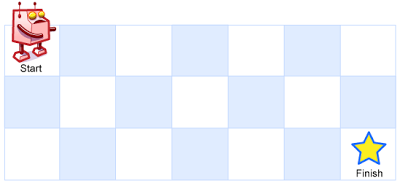A robot is located at the top-left corner of a m x n grid (marked 'Start' in the diagram below).
The robot can only move either down or right at any point in time. The robot is trying to reach the bottom-right corner of the grid (marked 'Finish' in the diagram below).
How many possible unique paths are there?
Note: m and n will be at most 100.
Example 1:
Input: m = 3, n = 2
Output: 3
Explanation:
From the top-left corner, there are a total of 3 ways to reach the bottom-right corner:
1. Right -> Right -> Down
2. Right -> Down -> Right
3. Down -> Right -> Right
Example 2:
Input: m = 7, n = 3
Output: 28

class Solution(object):
def uniquePaths(self, m, n):
"""
:type m: int
:type n: int
:rtype: int
"""
path_length = m + n - 2
right = n - 1
return self.factorial_dp(path_length, right)
def factorial_dp(self, n, r):
# math.factorial(n) / (math.factorial(r) * math.factorial(n - r))
memo_n = 0
memo_r = 0
memo_nr = 0
memo = 0
for i in range(n + 1):
if i == 0 or i == 1:
memo = 1
else:
memo = i * memo
if i == r:
memo_r = memo
if i == n:
memo_n = memo
if i == n - r:
memo_nr = memo
return memo_n / (memo_r * memo_nr)
'''
Z = [ [0 for j in range(m)] for i in range(n) ]
for j in range(m):
Z[0][j] = 1
for i in range(n):
Z[i][0] = 1
for i in range(1, n):
for j in range(1, m):
Z[i][j] = Z[i-1][j] + Z[i][j-1]
return Z[-1][-1]
'''